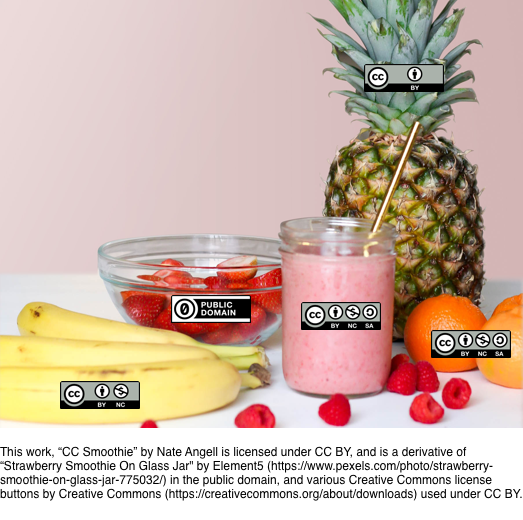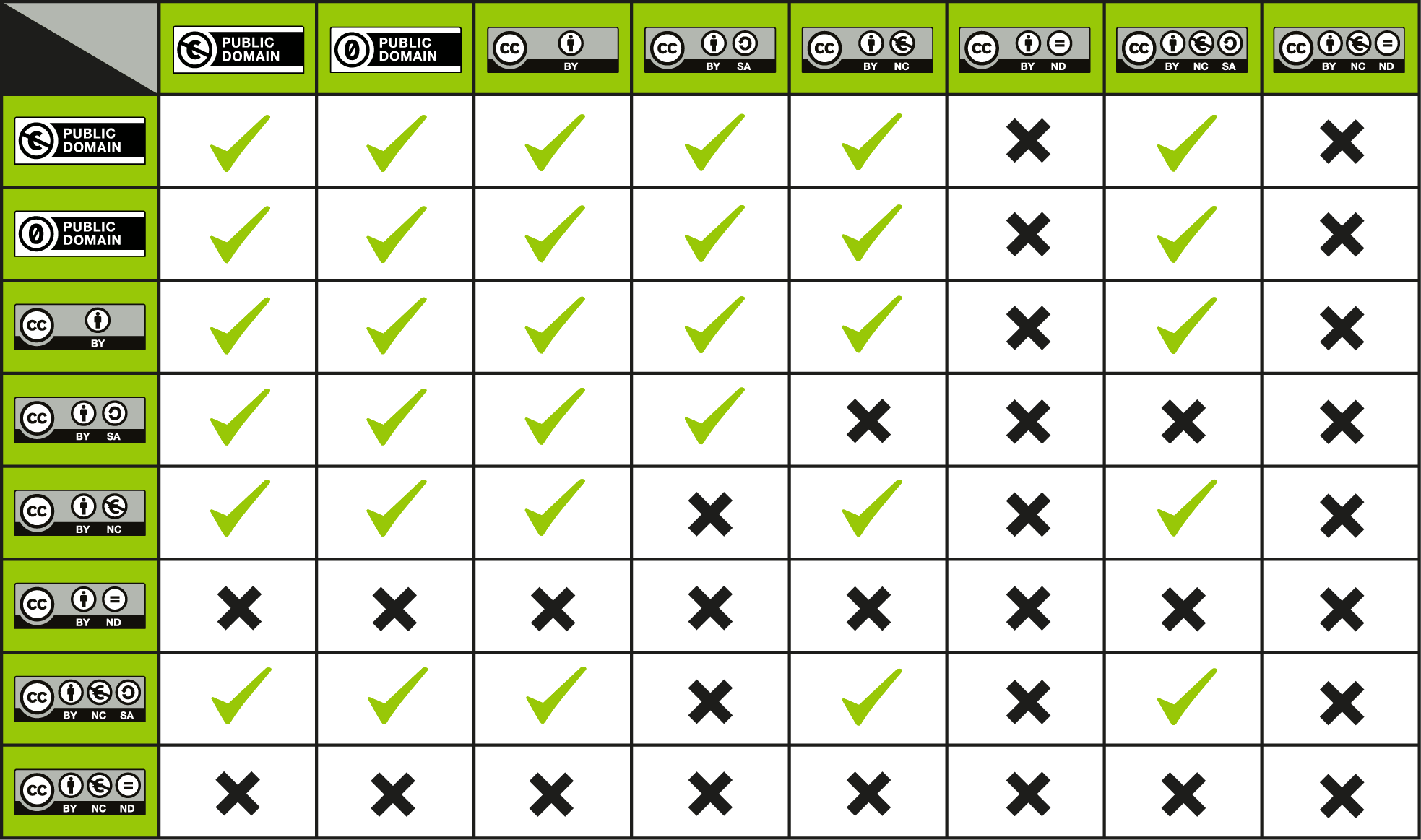
As defined on the first page of this guide, "Open Educational Resources (OER) are teaching, learning, and research materials that reside in the public domain or have been released under a Creative Commons license." Works in the public domain are the simplest to work with as there are not restrictions on how they can be used. Working with CC licensed materials can be more complicated. This guide is intended to help you navigate using CC licensed works in various situations.
Note: This guide was compiled by librarians and is informational only; it does not constitute legal advice.
Much of the impetus for developing OER has been in response to the reality that many students struggle with the high cost of textbooks and course materials on top of the many other expenses of college attendance. This has been exacerbated by the skyrocketing cost of textbooks, a trend that began in the mid aughts with an 40.6% increase between 2011 and 2018 (Bureau of Labor Statistics). The trend continued over much of the last decade, and it has significantly out-paced the rise in all other categories in its sector. Add to this the fact that many textbook publishers have sought to beat the trade in used textbooks by putting essential learning tools, like problem sets and study guides, online behind single-user access codes.
One of the justifications for legal protections for copyright is that it allows copyright holders to profit from their work, thus incentivising the expansion of our collective knowledge. This is certainly and essential consideration. However, this drive for profit is forcing many college students to make difficult choices like not purchasing some or all of their text books each semester.
When using traditional textbooks, faculty are forced to select the best available textbook and "make do." It's too much to ask students to buy several expensive textbooks, particularly if only a small portion of each text is really relevant to the course.
OER, on the other hand, allows for much wider use of materials. Users have permission to engage in the Five Rs of Oppeness*:
This openness enables faculty to create course materials that are tailored to the needs of their course. They can expand the representation on examples to reflect their students, add local context, and new content to support student learning.
*This material (the Five Rs) was created by David Wiley and published freely under a CC-BY4.0 license.
Adopting OER materials in a course--e.g. switching out a traditional textbook for an OER textbook--is the simplest use case in terms of copyright. In this instance, your responsibility is to ensure that you fully understand the licenses of the works you are considering and determining if the allowed uses are consistent with how you intend to use the work. Our Creative Commons Copyright Tools FAQ can help you understand the different licenses that you will come across when evaluating OER. Whichever text you choose, we advise that you carefully read the associated license as it is your responsibility to ensure that your usage of the work complies with the license.
There are two main ways that you can adapt OER by combining two or more works.
Adaptation or Remix. A remix or adaptation is when you build on an existing work to create a new work. In a simple adaptation you would add your own content--e.g. examples, explanations, course specific information--to an existing work. When remixing, you combine elements from two or more OERs with your own content to create a completely new work. In this instance, it is difficult, if not impossible, to determine where one work ends and anther begins. You can think of this type of use as a smoothie, where the different OER are the fruit and vegetables that you add to the smoothie. Once blended together, the resulting drink is a completely new creation (see image below left). The addition of new creativity is an essential part of determining if something rises to the level of an adaptation.
Collection. A collection is when you select a group of works, unchanged from the original, and organize them as distinct elements within a larger whole. You can think of a collection as a TV dinner, the different elements are complementary, and they are kept separate from each other (see image below right).
Check out the other tabs in this box for more information on copyright and adaptations/remixes and collections.


Some general rules to keep in mind when remixing OER are:
When remixing two or more works, you need to make sure that the works you will be using have compatible licenses. This chart can help you determine which licenses are compatible. Find the license of one work in the left-hand column, and the licenses of the other work in the top row. A ✓ in the box where they meet means that the licenses are compatible. An X means that they are not compatible unless a copyright exception or limitation, like Fair Use, applies. Remember, a CC license cannot disallow uses granted under copyright.

CC License Compatibility Chart created by Kennisland, published under a CC0 license, via CC Wiki.
When deciding on an Adapter's License, remember that it only pertains to your content. The original works will still be licensed under their original licenses. The below chart can help you decide which license to apply to your derivative. Find the license of the original work in the left-hand column, then read across the row to see which licenses you can use. Licenses with a green box are recommended by the Creative Commons. Those marked yellow are not technically incompatible, but the Creative Commons recommends against them. If you do decide to use one of these, you should make it clear that your work is made up of works under different licenses so that downstream users are aware of their obligations. Licenses that are grey are incompatible.

CC Adapter's License Chart, by Creative Commons, licensed under a CC-BY 4.0. via Wikimedia Commons.
If you create a collection using parts of CC licensed works, for example creating a textbook using chapters from five different OER textbooks, then then elements in the collection retain their original license as long as each chapter is unchanged from the original. If you add elements, like an introduction or separate chapters of your own, then they would be separate copyrights that you can license. You can also license the selection and arrangements of the elements in the your work. You need to clearly attribute each different elements so that downstream users know what their obligations are if they choose to reuse or remix elements of your collection.
As the elements in the collection are unchanged from the originals, a collection does not qualify as an adaptation, so you don't have to apply a ShareAlike-license to your collection even if one or more of the underlying works has such a license. Additionally, you can include elements from ND licensed works. You just have to make sure that you comply with the NC license terms if any underlying work is so licensed.
When deciding on an Adapter's License, remember that it only pertains to your content. The original works will still be licensed under their original licenses. The below chart can help you decide which license to apply to your derivative. Find the license of the original work in the left-hand column, then read across the row to see which licenses you can use. Licenses with a green box are recommended by the Creative Commons. Those marked yellow are not technically incompatible, but the Creative Commons recommends against them. If you do decide to use one of these, you should make it clear that your work is made up of works under different licenses so that downstream users are aware of their obligations. Licenses that are grey are incompatible.

CC Adapter's License Chart, by Creative Commons, licensed under a CC-BY 4.0. via Wikimedia Commons.
I have carefully selected and organized this collection of dog images. I present it here for your enjoyment and contemplation of the roles that dogs play in our lives.
The images in this collection are licensed under various licenses.

Dogs! by Eli Christman, via Flickr, CC-BY 2.0

Black Labrador Puppy, IDS.photos, via Wikimedia Commons, CC-BY-SV 2.0

Black Labradoodle, by Nurse90, via Wikimedia Commons, CC-BY-SA 4.0.
Cute Dogs 5 by Kevin David Pointon, via OPENCLIPART, CC0 1.0
When authoring OER, it is our choice how to license the work. Some things to keep in mind:
The Creative Commons' License Chooser tool can help you figure out which license is right for your work.
Cost of College Tuition Has Remained Stable since September 2019 : The Economics Daily: U.S. Bureau of Labor Statistics. https://www.bls.gov/opub/ted/2021/cost-of-college-tuition-has-remained-stable-since-september-2019.htm. Accessed 17 Apr. 2022.
"Remixing CC-Licensed Work" Creative Commons Certificate for Educators, Academic Librarians and GLAM. https://canvas.instructure.com/courses/4115022/modules/items/59808330. Accessed 20 Mar. 2022. Licensed under a Creative Commons Attribution License.